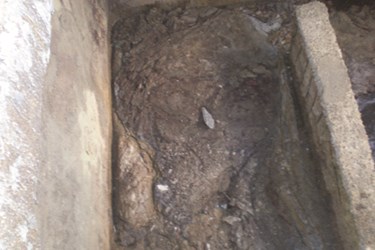Shear Power: How To Defeat FOG Once And For All

By Dr. J.H. Wakefield
Overcome the problem of fats, oils, and grease (FOG) by understanding it and choosing the right equipment.
Fats, oils, and grease (FOG) from municipal wastestreams are widely variant from each other, as municipal wastestreams tend to be. It is also maddeningly difficult to obtain meaningful data for FOG, partly due to this variance and partly because FOG are natural products. What will or won’t work for the removal of FOG is never universal, but there are parameters for success.
All FOG wastestreams contain hydrophobic components, meaning they contain “water-hating” parts that are insoluble in water. These hydrophobic components are usually less dense (lighter) than water and float on the surface. This results in clogging masses interfering with the physical and chemical functioning of the treatment process — both the collection and the actual treatment of the wastestream at the wastewater plant. This floating mass entrains other floating debris, making it even more difficult to remove. In short, this is probably the biggest and most aggravating problem that those working with collection systems and treatment systems encounter.
Keys To Overcoming FOG
The successful removal, alleviation, and control of FOG deposits in wet wells, lift stations, and grease traps will involve both physical and chemical considerations. The key parameters are: 1.) providing oxidation potential to the deposits, and 2.) providing a means to increase the surface area (and thereby the reactivity) by decreasing the size of components of the deposits into microparticulates.
FOG microparticulates are defined in wastestreams as very small hydrophobic organic particles (either solid or liquid, as in the case of emulsoids) that are stable within the wastestream. The solid’s structure on a macromolecular level may be lamellar (as in a composite or crystalline material, such as graphite) or branched (as in steel wool). The surface of these solid microparticulates is generally referred to as rugose, which means heavily wrinkled. Their decomposition depends on the microorganisms present and the enzymes that they provide. Upon microscopic examination of these particulates, one can readily observe the rugose (wrinkled) surface areas of the solid microparticulates, which results in their increased rate of degradation by the microbial enzymes.
Physical And Chemical Catalysts
The production of these microparticulates is accomplished by devices that provide a shearing environment and also deliver a charge of oxygen that can be assimilated into the various wastestreams and deposits encountered. Some devices are designed to engender an extreme shear on FOG deposits and transform them into reactive microparticulates. By actually increasing the availability of oxygen to resident microorganisms, as well as to enzymatic action on the FOG particulates as they are pulverized, a radical result on the deposits is achieved.
Note that shear and turbulence are the critical factors. The provision of oxygenation is, of course, a desirable feature; but some decomposition regimens occur under anaerobic conditions. No matter how the metabolic degradation of the wastestream is affected, these smaller particulates (with radically increased surface area) will be more efficiently degraded by the appropriate microorganisms and their enzymatic “packages.” This is a consequence of surface area and collision probabilities from the turbulence.
A small amount of ozone or other “charge carrier” molecule may also be injected to establish a charge on the formed particulates. This stabilizes the particulates in the liquid stream so that they don’t settle out in the collection lines as they are pumped into the wastewater treatment plant (WWTP). Depending on the size of the particulates engendered, ozone charging may not be necessary, as sufficiently small particulates will carry sufficient charge (colloidal particles) to remain in suspension. Of course, all this time, enzymatic action will be “working” on them from the plethora of microorganisms that are inherent in most collection systems and wastestreams.
There are several principles that enable FOG deposits to be degraded. We have seen that shear, turbulence, and enzymatic action are the “ball game” in this regard. Shear and turbulence are physical in nature, while enzymatic action is chemical. Three entirely different methods may be used to resolve FOG at the WWTP.
FOG Removal Systems: Choose Wisely
In some devices, the principle is to use a Venturi draw (by means of air lift bubbles or otherwise) to impact the wastestream solids against a sharp edge or other immovable object to generate microparticulates. As a circulation is developed, the wastestream becomes less viscous, thereby increasing the velocity at which the particulates are slammed into the immovable (and sharp) edge. The particulates are constantly reduced in size by this action, and it is relatively easy to provide oxygenation from the air lift bubbles used to engender the Venturi draw, as well as smaller diameter bubbles specifically tailored to create this outcome.
In other devices, the principle is to use a propeller-type mixing blade to reduce the size of the particulates. By judiciously choosing the type of mixing blade used, one can also entrain oxygen into the process from either a pure oxygen source or an atmospheric one.
In yet other devices, the wastestream is pressurized and then injected into a lower pressure zone, resulting in the destruction of the solid particulates into even smaller ones. These devices are more effective where the suspended solid levels are very low, and are usually dedicated to these applications. However, ordinary wastestream systems rarely, if ever, deploy this method.
As is the case so many times, the method chosen is the one that is the simplest to set-up, install, and economical with respect to power usage. In short, cheap is not only good, but essential. We have come a very long way in a relatively short time in addressing the FOG issue, and we can now control the situation expeditiously and economically.

Dr. J.H. Wakefield is a consulting scientist/engineer with more than 30 years of experience in water/wastewater treatment. He holds advanced degrees in microbiology and physical/analytical chemistry, and has been a practicing chemical and environmental engineer for many years.
